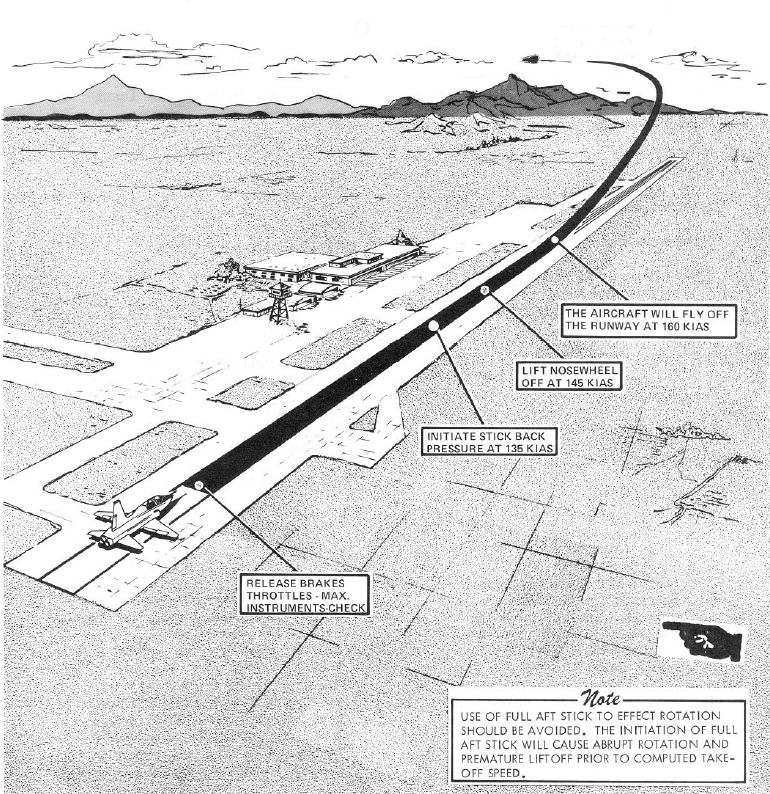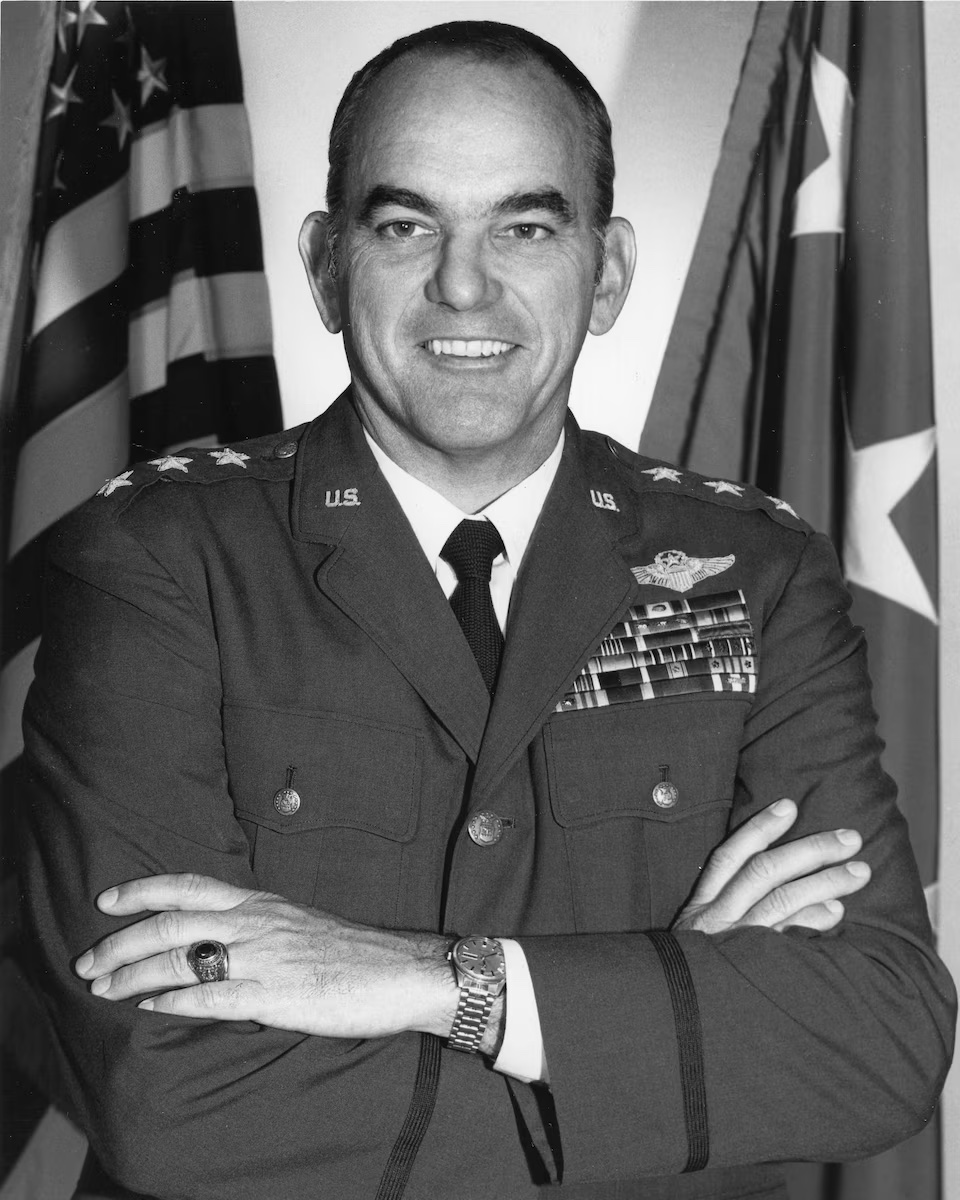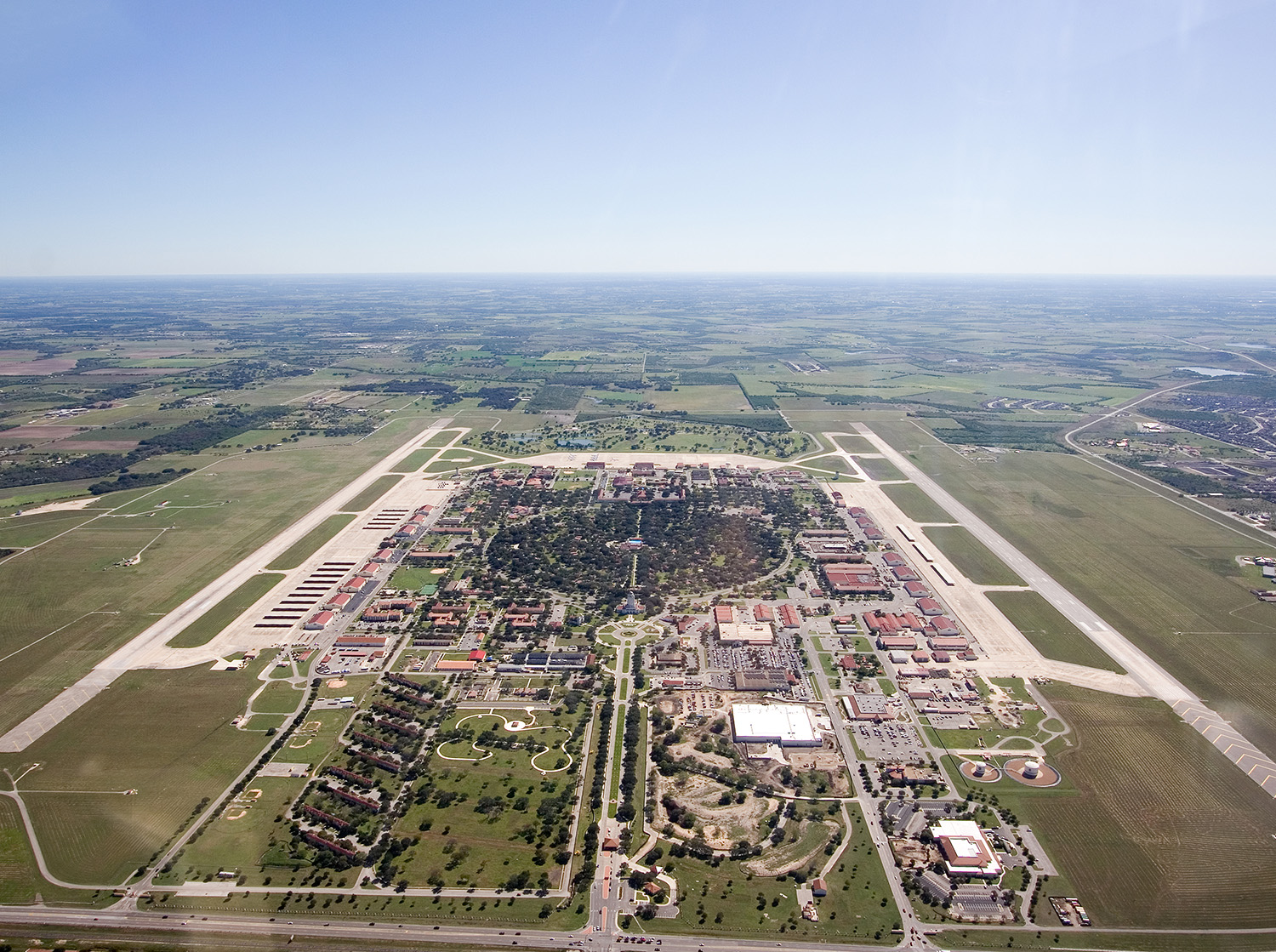I think most Air Force Accident Investigation Board (AIB) results are a model of objectivity and adhere to the ideals given to us at the Air Force Flight Safety Officer Course (FSOC): our purpose was to prevent recurrence. An exception to this happened whenever there was a general officer involved, in that case the purpose was to protect that general's reputation. This accident is a perfect example.
— James Albright

Updated:
2023-10-01
This crash happened about seven years before I flew the Northrop T-38 Talon in training and remember it discussed as the general attempting an aileron roll after takeoff, so the lesson was don't do that. At the time we were told an aircraft malfunction caused the crash, but I since found out otherwise. I filed a Freedom of Information Act request (FOIA) for the actual AIB report and was given the report with portions of the findings, evaluations, analyses, conclusions, and recommendations redacted. The reason given was an exemption in the United States Code, Title 5, Section 552(b)(6), which says disclosure is not required if it will "disclose information of a personal nature where disclosure would constitute a clearly unwarranted invasion of personal privacy."
The odd thing about this explanation is the parts they did disclose include the names of both pilots. Furthermore, of the many FOIA requests I've been granted over the years, this exemption was never used.
I knew one of the expert witnesses called in to help with the investigation. Professor of Aviation Psychology Chaytor Mason, University of Southern California, was called in to solve what the Air Force investigators couldn't. I took a class he taught at the Air Force Safety Officer Course in 1985 and he told us what really happened. I'll cover what the redacted Air Force report says and I'll add my best recollection of Professor Mason's account. My purpose here is to demonstrate to pilots just how insidious the pressure from flying with an overconfident and undisciplined pilot can be. Be that undisciplined pilot be a general officer or the owner of the airplane. If you are in the situation where you are the legal pilot in command but the person flying the airplane has power over you and believes they fly with their own set of rules, you are being set up for a fall. There are many examples like this both inside and out of the military. If that other pilot refuses to follow your rules as the PIC, you shouldn't allow them to fly at all. Even if that means you lose your job.

1
Accident report
- Date: 9 Sep 1972
- Time: 1203 CDT
- Type: Northrop T-38
- Operator: USAF
- Registration: 70-1956
- Fatalities: 2 of 2 crew
- Aircraft Fate: Destroyed
- Phase: Takeoff
- Airport: (Departure) Randolph AFB, TX (KRND)
- Airport: (Destination) Scott AFB, IL (KBLV)
2
Narrative
This accident involved T-38A, SN 70-1956, which crashed shortly after takeoff on Runway 14 L at Randolph Air Force Base, Texas. Both occupants were fatally injured. The aircraft was destroyed.
Source: USAF Accident Report, T-38 70-1956, ¶1
The aircraft appeared to accelerate normally and lifted off after 3000 feet of roll. Recomputation of takeoff data confirmed this as the normal takeoff roll. The initial rate of rotation appeared to be normal, however, the aircraft rotated shortly after lift off to an abnormal pitch attitude. The aircraft continued to climb in this attitude, attaining a maximum altitude of approximately 150 feet. At about this time, the left wing dropped noticeably and the aircraft began a rate of descent. The nose then appeared to drop toward the horizon followed by a sudden bank to the right to approximately a wing's vertical position. At approximately 5,400 feet from brake release, the aircraft was in a clean configuration with 90 degrees of right bank, nose slightly high, less than 150 feet above ground level in a high rate of descent. The descent continued at an increasing rate as the angle of bank decreased back toward the wings level position. Just prior to impact the pitch attitude remained slightly nose high. Impact occurred 60 feet right of the runway, 6,800 feet from brake release in a 17 degree right bank, 5 degrees nose high pitch attitude. Airspeed was approximately 198 knots. There was no ejection attempt by either occupant, and both were fatally injured by the impact.
Source: USAF Accident Report, T-38 70-1956, ¶2
3
Analysis
Redacted.
Source: USAF Accident Report, T-38 70-1956
4
Cause
Primary Cause. Undetermined.
Most Probable Cause. Supervisory factor in that the IP allowed the aircraft to be flown into a nose high, low airspeed, stalled condition at an altitude from which a safe recovery could not be made.
Possible Cause.
1. Operator factor in that the aircraft was inadvertently flown into a stalled condition at on altitude from which a safe recovery could not be made.
2. Material factor in that en undetermined flight control problem caused the aircraft to become uncontrollable.
3. Miscellaneous unsafe factor in that an unknown foreign object was introduced into the flight control system causing the aircraft to become uncontrollable.
Source: USAF Accident Report, T-38 70-1956
We were taught at FSOC that if the official list of causes don't seem to correspond to the facts of the case, look at the recommendations to find out what really happened. . .
Recommendations
Redacted.
Source: USAF Accident Report, T-38 70-1956
I was told by a person who participated in the investigation (see the Postscript below) that there were no recommendations to correct any material factors in the flight control system or to prevent the introduction of foreign object damage into the flight control system after this crash. Therefore, the person said, items 2 and 3 listed above are false.
5
Postscript
When I attended FSOC, it was a three month long school taught at Norton AFB, CA. It was a lot of math, a lot of lab work, and a lot of time dissecting previous crashes to familiarize ourselves with the process. One of our favorite professors was Chaytor Mason, on loan from the University of Southern California. Our introduction to him was after being in class for over a month and by then we had grown accustomed to the classroom routine. I wasn't looking forward to listening to an aviation psychologist for several hours each day for the next few weeks. Was it really worth that much of our time? For his first day with us, it appeared he was late. We sat in class, facing forward, for over ten minutes wondering how much latitude we should give this civilian professor. Most of the students were making idle chatter or napping. I was doing a crossword puzzle. All of a sudden there was a loud gun shot inside the classroom. I had never heard such a loud sound from so close. The students on my left and right sprang up from their chairs. I looked back to where the sound came from. There stood Professor Mason, holding a starter's pistol with a trail of smoke streaming from the barrel.
"Take a look at your fellow pilots," he said. "That is how they will react to a sudden and violent event in an airplane. This is your first lesson in aviation psychology."
Chaytor Mason turned out to be the highlight of FSOC; he really knew his stuff. Not only that, he had been "out there," conducting many Air Force mishap investigations where human factors played a pivotal role. Side note: I am not sure why the Air Force insists on calling these mishaps. That was covered during FSOC, but I remember thinking the explanation was wrong. "Accident" makes it sounds like the event was serendipitous. "Crash" doesn't always cover it. "Incident" seems to downplay it. But "Mishap" seems too trivial a word when loss of life is involved.
Chaytor was called in for this T-38 accident because the evidence didn't match what nearly one hundred eye witnesses reported. First oddity: why were there nearly one hundred eye witnesses? Second oddity: nearly all of these witnesses were not only current and qualified in the accident aircraft, they were instructor pilots in the aircraft. But we are getting ahead of ourselves in this story.
The players
You cannot understand what caused this accident unless you understand the players involved.
The aircraft
The T-38 held many world performance records about the time of this accident and two years later, became the bird of choice for the USAF aerial demonstration team, The Thunderbirds. That performance came at a cost, however. The airplane was unforgiving if you got it too slow. The wing didn't stall the way most pilots would expect. Once you got through the critical angle of attack, the wing continued to fly but with more induced drag than lift and you could develop very high sink rates. If you were low to the ground, there wasn't much you could do to survive. Fighting it would result in the wings rocking, what some call a "saber dance." This never worked. The only possible recovery was to point the nose down, break the stall, and pray you have enough altitude left. Usually you didn't. So, very obviously, don't stall. The illustration shown here doesn't do the takeoff justice. With both afterburners engaged, takeoff happens quickly. If you rotated at 145 knots, you would be airborne in a second, blasting through pattern altitude a few seconds later, and you could be at cruise altitude in a few minutes. (The airplane held the world time-to-climb record for years: 30,000 feet in 3 minutes.) The wings were razor thin and getting too slow was a quick way to becoming the subject of an AIB.
The pilots
The pilot in the front seat was Lieutenant General George Simler, commander of the Air Training Command (ATC) which was headquartered at Randolph AFB, Texas, the location of the accident. He had a distinguished career during World War II, including being shot down behind enemy lines and evading capture. As the commander of ATC, he had at his disposal any of the training aircraft and chose always to fly this particular T-38, which was the last one ever delivered to the Air Force. This was to be Simler's last flight as the ATC commander as he was on his way to Scott AFB to take command of the Military Airlift Command (MAC) and be promoted to full General.
As a general officer, he was required to have an instructor pilot fly with him at all times. For this duty, he flew with his aide, Captain Gil Gillespie. This was considered highly desirable duty for a young Air Force officer, guaranteed to ensure early promotion, provided he stayed in the general's good graces.
The location
Randolph Air Force Base, Texas, is one of the prettiest bases in the Air Force. At the center is a tall building, often called the "Taj Mahal." Building 100 is a two-story affair with a 170-ft. water tank built into its center structure. The photo shown here is looking south. There are two parallel runways, one west of the base and the other to the east. Back then, the T-38s used the east flight line and the T-37s used the west. The east runway had the instrument approaches and back then it also had the only control tower. (The other runway used what is called a "Runway Supervisor Unit" which was little more than a shack next to the runway. Another tower has since been built.)
Of particular note, Professor Mason said, the witnesses who were current and qualified T-38 IPs were all watching from the east flight line. The accident aircraft departed from the west runway. (I don't recall why this was so.)
Eye witness accounts versus the crash site
When Professor Mason was called in, the investigation already gathered the usual evidence and spoke to all the witnesses. Every witness said that the T-38 rotated, did an aileron roll, and crashed. It seemed to be perfect: not only were these witnesses pilots, they were current and qualified in the accident aircraft. These witnesses did aileron rolls in the T-38 for a living, in fact, these were the instructors who taught new instructors how to instruct. The fact so many of them were certain of the aileron roll gave great weight to that hypothesis.
There was a problem with this, however. The crash impact site was very small. It appeared the airplane impacted the ground almost nose first. If it had been an aileron roll, the ground impact should have been spread over a larger area. The technical members of the AIB were stumped. That's when they called Chaytor Mason.
The Auger Inn
Professor Mason interviewed many of the witnesses beyond the normal "what did you see" questions and realized that much of the mindset of the pilots and witnesses were set the night prior at the bar in the basement of the officer's club, known as the "Auger Inn." The bar's name comes from the Air Force slang about "auguring in" to the ground, as if drilling into the ground, following a crash. The name is all too apropos to the actual crash site of the accident aircraft.
From these interviews, Mason determined the following:
- The pilots had just returned from a week of visiting all the ATC bases in Lt Gen Simler's command. For each day's takeoff, the general was rotating the nose of the aircraft too high. The IP was reluctant to say anything until the flight the day before the accident when he nudged the stick forward during rotation. General Simler exploded with anger, telling Gillespie to never again touch the stick when he was flying.
- That night, at the Auger Inn, the general was surrounded by members of the headquarters staff he had just left, and by many T-38 IPs. He was heard to have said, "make sure you make it to the flight line tomorrow morning. I am going to put on a demonstration of just how to fly the T-38." He was also have said to tell a few that his aide didn't know how to really get the most out of the T-38. The stage was set.
- The next morning, the crowd's view was from across the base where they could see the T-38 taxi out and begin its takeoff roll. They were able to see the aircraft's initial climb and the start of a roll to one side. But then, their view was obstructed by the Taj Mahal. Following the path of the aircraft, when it reappeared behind the building, they could see it continuing its roll. Ergo: aileron roll. The next thing they saw was the fire ball from the crash.
What really happened
Given the general's tendency to over-rotate, the dressing down he gave his aide for nudging the stick the previous day, and his proclamations at the Auger Inn, it appears he rotated to such a high angle the aircraft started stalling right after takeoff and one wing dropped. This gave the appearance of the start of a nose high aileron roll. Then the airplane disappeared from view. The aircraft then reversed its roll as the pilot tried desperately to regain control. The roll reversed again, just then the aircraft reappeared to the witnesses, who perceived the completion of the aileron roll.
Professor Mason's conclusion was that the aircraft fell out of the sky in a full stall, hence the contained size of the crash site. The report says the aircraft was "slightly nose high" when it impacted doing 198 knots. That airspeed doesn't make sense given the aircraft's attitude and size of the impact site. I do not believe the accident report. I believe Mason was correct: the general over-rotated, stalled the aircraft, and both pilots died as a result.
Lessons learned (there are a few)
Lt Gen Simler had a storied career and deserved a lot of respect for his early days as an aviator and later on as a commander of very large organizations. The Air Force has a collective (and willful) blindness to the dangers posed by having such men fly aircraft so late in life where they come to believe they are infallible. The answer that the assigned instructor pilot will prevent the general from doing something stupid is equally blind.
The loss of Captain Gillespie is tragic on many levels, the utmost of which is that he could see the situation unfold but felt powerless to stop it. He was listed as the cause of the crash and he did not deserve that.
Aircraft accident investigation used to be wrapped up in figuring out what was going on in the cockpit by dissecting the remains of the aircraft. With the proliferation of cockpit voice and flight data recorders, that part of the investigation has gotten easier. Getting into the pilot's head still remains a challenge and there will always be a call for aviation psychologists like Professor Chaytor Mason.
The lesson that should be taken away by the rest of us is that no matter how good we are, or think we are, we will be blind to these kinds of hidden dangers. If you are flying the aircraft beyond the limits you preached when you were younger, you are setting yourself up for a fall. If you are responsible for flying with or for someone pushing you beyond those same limits, it is important to realize that while holding fast to your integrity could cost you your job, at least you will be alive for the job hunt to come.
References
(Source material)
USAF Accident/Incident Report T-38 SN 70-1956, 9 September 1972, report dated 20 Sep 1972




